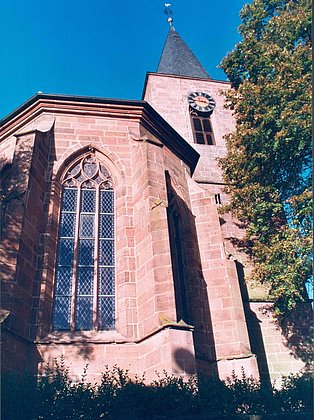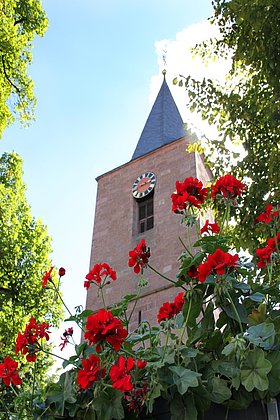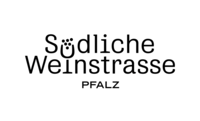Contrary to what the inscription in the lintel above the north portal (translated: "under the reign of Emperor Maximilian and Ludwig of the Palatinate in 1513") suggests, the Rohrbach church was not completed in 1513, but only around 1519/20. But the inscription, which is noticed by many churchgoers and visitors, is nevertheless supposed to be the reason for a short look at the history of the church five hundred years later.
The construction was started in 1484 on St. Bartholomew's Day (August 24) (see inscription in the south-eastern choir buttress), the steeple may have been built as early as 1479 (date on the outside of the steeple). There was a predecessor church of which two door lintel fragments are preserved (around 1150; see south wall in the nave). The new church also served as parish church and the local lower nobility as house church and burial place. The gravestones in the southern side chapel and in the choir room bear witness to this. The building was constructed in (late) Gothic style and as a hall church without side aisles.
Soon after the construction of the church, Rohrbach experienced the disappearance of the local nobility and the emergence of the new confessions resulting from the Reformation during the period of upheaval of the 16th century. At this time Rohrbach belonged ecclesiastically to the diocese of Speyer and politically to the Electoral Palatinate. After many changes, the Calvinistic/Reformed confession was introduced by the electoral princes.
In 1622 the church was severely damaged in the Thirty Years' War and was rebuilt around 1634/35. The roof was lowered. Instead of a vault, a flat wooden ceiling was installed inside. The choir arch was lowered and made round (instead of the previous Gothic pointed arch) and placed on a console in the north. The pulpit was built.
In the period from 1685 to 1706, the conquest of the Palatinate by the French, the peace treaties and the religious policy of the electors finally reintroduced the practice of Catholic worship in Rohrbach (see inscription in the pulpit basket). The church became a "simultaneous church" and since then has served both confessions as a place of worship. In the course of time there were different official and contractual regulations for its use. Originally, the Catholic community was mainly assigned the choir room. Today's agreement leaves the entire house of worship to both congregations for use, with the exception of the sacristy.
In the 18th century the baptismal font, confessional, choir stalls and high altar were built. The west and north galleries and the Hartung organ from 1751/52, which is still preserved today, also date from this period. After changes to the window and interior decoration in the 19th century and finally through the major renovation in 1989/90, the church received its present form.





